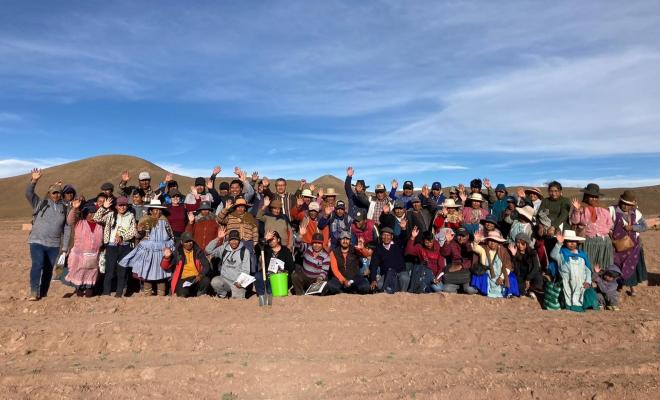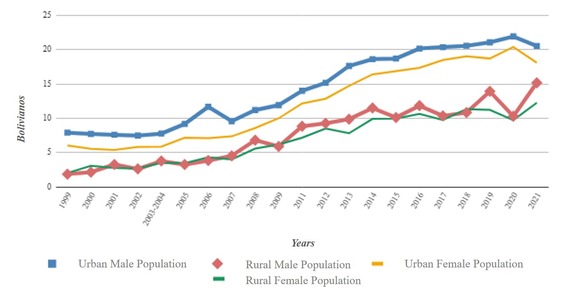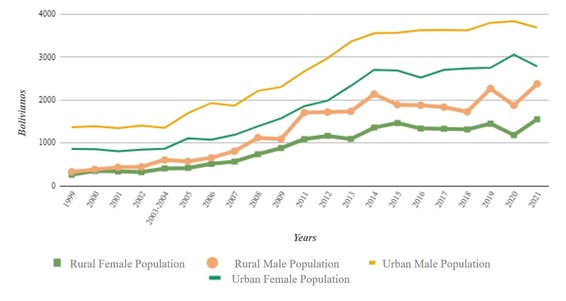Gender inequality and the empowerment of rural women

Daniela Romero of INESAD Bolivia shares some of the thinking behind the team's research on its GLOW project: Creating indigenous women's green jobs under low-carbon Covid-19 recovery in Bolivia's quinoa sector.
Gender inequalities are the result of the historical persistence of systems and of structural discrimination and exclusion factors. In the specific case of women, exclusion is a multi-dimensional issue which leads to precarious situations for women in the conditions and their actions in economic, social and political spheres. The sexual division of labor, as a structural reality, is one of the main bases for this exclusion, and, in general, for generating inequality and injustice, mainly of an economic nature, affecting women. Across the globe, in general, women earn less than men, as it is more likely form them to work independently and in unpaid family jobs. Besides this, women are more prone to performing low-productivity activities and working in the informal sector, with less likelihood of mobility towards the formal sector than men.
Also, gender inequalities in the use of time within households are still high and persistent, particularly in developing countries. Combining paid and unpaid work, women end up working more hours than men, which makes them devote less time to education, recreation, political participation, and their own care, or not allowing them to earn salaries comparable to those of men. In the case of Bolivia, this is observed in the indicators of Red EMINPRO on changes in labor income by gender and geographical area in the last decades:
Graph 1. Average labour income per hour of principal occupation by gender and geographical area
(in bolivianos)

Source: Red EMINPRO, 2022
Graph 2. Average monthly labour income from principal occupation by gender and geographical area
(in bolivianos)

Source: Red EMINPRO, 2022
Both graphs reveal that although there are no large differences in income per hour of work, there are large differences as to average monthly income. This is explained precisely by the number of hours that women assign to household tasks at the expense of dedicating more time to employment and better income. Also, it may be observed that rural women are those most affected by this condition.
In this context, the focus of gender inequality emerges as a response to be able to modify these structural conditions with the aim of achieving equal enjoyment of rights, duties, opportunities, and resources by women and men. Associated with this focus is the concept of empowerment, which constitutes a necessary tool on the road towards equality, given that it involves the impetus of people’s capacity to decide on their own wellbeing based on the conditions existing and created externally and internally. In this way, it ensures that vulnerable groups such as rural women are able to build their empowerment, and with this, make equal their capacities and benefits, as well as being visible agents of development under conditions of equality with their male peers.
The empowerment of rural women and its importance in sustainable development
The conceptualisation of empowerment emerged in the 1960s with the African-American civil rights movement and Paulo Freire’s theory on the development of critical consciousness. Alsop et al. (2006: 1) define empowerment as “the process of improving an individual’s or group’s capacity to make intentional decisions and transform these decisions into desired actions and results”. This capacity for decision-making is influenced by two groups of factors: one related to the agency and the other one to the opportunities structure. By establishing the “rules of the game” for the exercising of the agency, the institutional contexts determine, to a lesser or greater degree, its level of effectiveness. They say these rules may also affect the accumulation of assets, reserves and determine the value of the benefits derived from such assets.
In the particular case of women, and specifically rural women, Sustainable Development Goal No. 5 of Agenda 2030 concentrates on the empowerment of girls and women, but is particularly aimed at supporting rural women, who continue being the most vulnerable. Rural women play a fundamental role, but face considerable limitations, such as limited access to land ownership and to accessing resources.
Despite this, women are the backbone of rural economies, especially in developing countries, as they make up half the world’s farmers, and in recent decades their participation in agriculture has increased. The number of households led by women has also increased as more men have migrated to cities. As main care-providers of their families and communities, women are responsible for providing food and nutrition, and are the link that joins agricultural exploits and family nutrition.
Given this, women’s empowerment is highly important, as the different activities and actions that they perform in their role are the ones that ensure the wellbeing and development of rural communities. Hence the need to bolster their agency and to generate the conditions needed for them to perform this role of continuing to be essential in national and international government agendas. It is evident that rural women began this process of empowerment long ago; albeit, the external conditions in which they function continue to be very limiting. However, prompting this empowerment must go beyond achieving gender equality, which despite constituting an important first step, must aim at sustainability by means of gender equity. The latter implies understanding, defining and acting on the focused needs of rural women as to infrastructure, access to machinery, inputs, spaces for trade and decision-making, and sustainable income sources.

